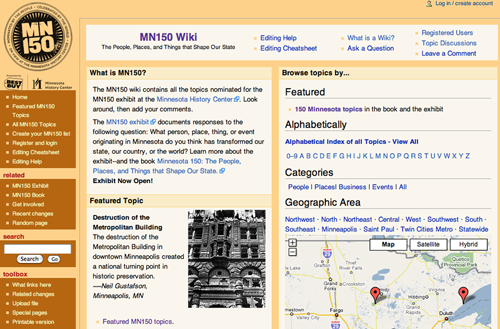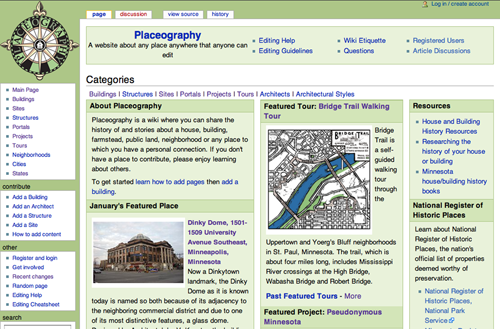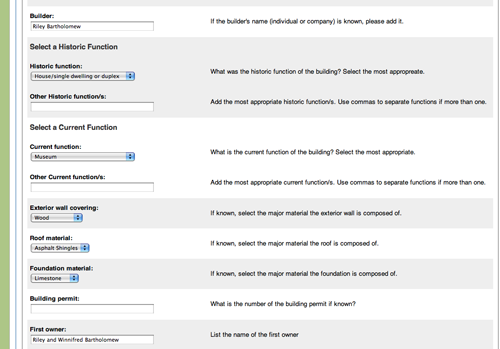Introduction
Creating, fostering, and sustaining a community is essential to the success of a wiki. There is tremendous competition for the time and contributions of content creators and editors. For new projects, collaborators must determine that the wiki has sustainability, adequate technical support, and the ability to reach their intended audience. They want to see why they would share their information or help build a new wiki. Some of the lessons of running a small business such as an independent coffee shop or book store are applicable here. Greeting and acknowledging the contributions of newcomers, providing individual assistance for those who need training in starting to add content, and providing a space for an organization to encourage visitation and engagement are essential activities to foster a relationship. This paper provides practical, executable strategies for launching a community-focused wiki. Several tactics for different community needs and different sized organizations are discussed.
The Minnesota Historical Society’s (MHS) journey into wiki communities began in 2006 when we hosted a roundtable discussion with other museums in the Minneapolis/Saint Paul area on ways to engage the public using technology tools in our upcoming MN150 exhibit. Their advice was that a wiki would be a terrific way to collect and disseminate history. After all, Wikipedia had shown there is an army of talented volunteers ready to collaborate, so perhaps its success would be applicable. However, those who had created public wikis cautioned us that our largest challenge would not be vandalism or slander, but simply non-use: few people would bother to contribute wiki content.
Over the next two years, the MHS launched two wikis - the MN150 wiki (http://www.mnhs.org/mn150wiki) and Placeography (http://www.placeography.org) - and was faced with the challenge of how to make these wikis relevant to a community, to encourage collaboration, and to receive contributions. The two wikis demonstrate different collaboration techniques to building wiki communities, and the level of collaboration differs significantly.
MN150 Wiki
The MN150 wiki launched in October 2007, to coincide with the opening of the MN150 exhibit. This exhibit marks the sesquicentennial of Minnesota statehood by exploring the 150 most influential forces in the state's history - the people, places, events and things that caused change in Minnesota and beyond. The exhibit was curated by the public through an open nomination process which drew more than 2,700 nominations. Some topics, such as Bob Dylan, received multiple nominations. A committee of staff, community members and subject experts selected the final list of 150 topics, basing their choices on the compelling case made by the nominator as well as the potential for each topic to be developed into a successful exhibit component. Each topic is displayed in the exhibit with the winning nomination and some historical context.
Fig 1: The Home Page of MN150 Wiki http://www.mnhs.org/mn150wiki
The exhibit development team wanted a way to present all of the nominations, regardless of whether a nominated topic or the actual nomination was included in the exhibit. We wanted a way for nominators to find their nomination. We could have accomplished these goals with a printed list in the exhibit or a searchable database, but we chose a wiki because we wanted to explore how to make history collaborative, given that the entire nomination process had been a public collaboration.
So we built the wiki using MediaWiki. Rather than trying to convert the 2,700 nominations into MediaWiki’s MySQL database, we chose to hand enter each topic as a wiki article. Each topic/article shows all of the nominations, the curator's historical context, images, related resources, and a section for the public to share memories. Because we had just three months to complete this massive effort, we recruited volunteers to assist in the content entry. The wiki proved to be an excellent tool for volunteers collaborating with the wiki development team because we could track the editing history and have team discussions on the wiki talk pages.
To make the wiki feel familiar to users, we designed the user interface so it resembles Wikipedia (http://www.wikipedia.org). We placed two kiosks in the exhibit gallery, and the wiki was included in much of the promotion for the exhibit. We were ready for the public to collaborate.
But the public hasn't collaborated in large numbers. With more than 400,000 page views, there are plenty of people browsing the site. They are viewing the list of the 150 topics as well as the list of all nominations; each of these pages has had more than 24,000 visits. They are searching for the nomination they submitted, and they're flocking to the articles about Prince, Betty Crocker, Paul Bunyan, Bob Dylan and the 1980 U.S. Olympic Hockey Team. However, they are not contributing to the historical context or adding memories. A "Create Your Own MN150 List" feature was envisioned as being as a way for members of the public to participate because they could exhibit their choices or add topics. However, of the more than 150 registered users - we require registration to reduce vandalism - only 17 people created their own lists.
Why was there minimal collaboration? One factor could be the difficulty of editing content. Although MediaWiki has an editing toolbar, knowledge of wiki markup language is required for sophisticated editing. This factor was confirmed in usability testing, so we built in pre-formatted templates and cheat sheets to assist new contributors. Another factor is that the wiki is not promoted unto itself, so that the primary way people find out about it is when they are in the exhibit gallery. Also, contributing to the historical context requires more thoughtful consideration than is conducive to an onsite experience. There has been some discussion with the Education group to create post-visit lesson plans that incorporate the wiki. Finally, a major factor is that once we launched the wiki, there were no resources assigned to promote or nurture it.
While the MN150 wiki satisfied the goal of presenting the submitted nominations with some historical context, it isn’t enticing community collaboration. We learned from MN150 that adding content to wikis must be easy, the content should compel a community to act, and the community must be nurtured.
Placeography
During the time the MN150 Wiki was being planned and developed, we were developing Placeography, a wiki focused on house, building, and other place histories.
Fig 2: The Home Page of Placeography http://www.placeography.org
Background
The MHS offers popular classes teaching people how to research their home's history. We learned that house history is a passion with many people. This interest in house histories was reflected on other Web sites. For example, there were individual house blogs - people journaling about the progress of restoring their homes. Before the real estate bust there were many Realtors blogging on house histories in an effort to entice potential buyers. Many neighborhood and preservation organizations had Web sites with out-of-date postings concerning historic and threatened houses in their neighborhoods. There was even a Bungalow Club on-line. However, one thing was obvious: while there was a definite interest in house history, there was no comprehensive space for recording house and building histories on-line.
Before creating our own wiki, we surveyed many existing sites. We discovered wikis focused on specific geographic communities, such as Davis Wiki (http://www.daviswiki.org) and Bloomingpedia (http://www.bloomingpedia.org/wiki/Bloomington), which focus on the cities of Davis, California, and Bloomington, Indiana, respectively. Archiplanet.org (http://www.archiplanet.org), an active wiki with many of the contributions coming from architectural firms, appears to be more geared to the works of larger architectural firms and some major landmarks throughout the world. We also investigated Wikipedia, an extensive and impressive on-line encyclopedia familiar to the vast majority of people. There you can find historic properties in Saint Paul, Minnesota such as the James J. Hill House and the Saint Paul Cathedral. Wikipedia contributors (2009) define policies to determine whether content is suitable for inclusion. These buildings have been deemed notable enough to be included in Wikipedia. Wikipedia has further policies requiring verifiability and barring original research; while necessary for an encyclopedia, these are seen as too exclusive for our mission. Thus, adding an article for your ranch house or suburban rambler, or even extensive information detailing companies and workers that helped build the Saint Paul Cathedral, is more than likely to wind up on the digital cutting room floor. After exploring a variety of possibilities, we concluded that to meet our goals of creating a site for anyone to add the history of a house and for people to freely add memories of places of local and personal significance, our best option was to create a new wiki.
For the new wiki, which we named Placeography - to write about places, we established several project goals. First, we wanted to provide a way for the public to share the history of a house, structure, or property with a personal connection to them. The MHS Library teaches house history classes. This wiki would give us a chance to see the results of our educational efforts and give class attendees an opportunity to share the results of their research. We also wanted to provide a way for the public, especially those not able to visit the library in person, to learn about the history of places in their communities of interest. Beyond the standard architectural and historical data about buildings, we were interested in gathering personal stories about buildings and places. Giving life to the phrase, "if these walls could talk", we envisioned generations of families sharing stories of when they inhabited a house, each contribution building upon those that preceded it.
Another important goal for the project was fostering interest in historic preservation, tying in with an institutional mission of the MHS and its State Historic Preservation Office. We saw Placeography as an opportunity to collaborate with public libraries, local historical societies, other museums, and historical preservation groups to promote awareness of the wiki and to train local communities about how to use the wiki. Placeography could provide added value to these partner organizations by providing them with local portals to the wiki. We saw Placeography as a vehicle to recognize buildings and structures important to individuals and communities which are significant but do not necessarily meet the formal criteria of the National Register of Historic Places (NRHP). Our final goal was to increase awareness of other MHS place-related on-line resources such as our photo and art collection, Minnesota Place Names, MHS's historic sites, and the NRHP database.
Building Placeography
We started meeting as a team in May 2007. The team included staff from the MHS Enterprise Technology Department (ET) and from the Library, giving us both technical expertise and historical research experience. Two interns have made important contributions, also. The ET staff built the technical infrastructure. Library team members worked on the content and user side, doing property research and working on pull-down menus, user help, rules of conduct, links to sources and house history tutorials.
In the fall of 2007, Placeography went live. The initial site content came from a collaboration of a Minneapolis community theatre organization, a local private college, and MHS museum and ET staff. Their work produced an exhibit at the Minnesota History Center and Web content for Placeography. The Right on Lake Street project (http://www.mnhs.org/lakestreet), rich with images and memories, showed us and others the possibilities of creating an on-line community history.
The team was then able to begin adding entries and creating information to help users add content. Before launching the site publicly, we wanted to create a significant number of entries so that potential contributors and partners would see it as a viable entity and would have a variety of models for articles. Members of the Placeography team entered a number of properties and encouraged our friends and colleagues to contribute. Our first intern spent her summer doing research on over 75 properties. We officially launched in February 2008 with a press release. The press release resulted in an on-line news article and a live interview on a local talk radio station. Even before the release, a local television reporter had discovered the site and featured Placeography as a favorite Web site in a news broadcast and on the station’s blog.
Growing the placeography community
When you create a wiki like Placeography and seed it with a number of entries, you can sit back and wonder: If we build it will they come? However, we learned from the MN150 Wiki that we couldn't just wait for contributors. We needed to go out and build a community and engage partners to help make Placeography a success. We started by contacting some individuals who had done extensive research that was not yet available on-line. For example, an active trade union member who has done extensive research on sites connected with Saint Paul labor history offered his information to Placeography, seeing it as an opportunity to create more access to information about labor history and interest in preserving buildings associated with labor. Seeking an on-line home and additional suggestions, the MHS book curator offered his compilation "Pseudonymous Minnesota," the real models for fictional Minnesota places.
We initiated our search for organizational partners with some local community, preservation, and historical organizations with whom we had worked previously in one way or another. Sometimes the groups we approached, thinking they would be great partners, turned us down or delayed responding to our invitations to meet. It proved most difficult to engage the first partners. We attended numerous meetings with individuals, volunteers, and board members. Once we had an agreement, we created a portal page for the organization. For some of our first partners, we did a lot of the entry of their material. It was a learning process for us as well as them. Developing relationships with committed partners required much initial time, footwork, and perseverance. The organizational partners are vital as they bring groups of students and volunteers who can be active participants, along with many members and supporters.
The partnerships we have formed with colleges and universities have allowed college students to provide valuable additions to Placeography. When students have class assignments or seek internships, they are able to utilize their technical skills to quickly add new entries and content. We have worked with students primarily as interns or through classes. Some professors have assigned students the task of adding one or more entries to Placeography as part of their course requirements. We have had two successful collaborations with college students at the University of Minnesota, one with an architecture school class and the other with a public history class working with the Jewish Historical Society of the Upper Midwest.
After meeting with historical and community organizations, we found it was clear their interest level was high but they had few resources. So the MHS is placing some of our volunteers with our partner organizations to assist them with content entry. We placed a volunteer with the Jewish Historical Society of the Upper Midwest to help create articles about Jewish synagogues throughout Minnesota, including those no longer standing or being used as synagogues. We placed a volunteer with the Preserve Minneapolis group, to help identify and enter historic properties in each of Minneapolis’ eighty-one official neighborhoods.
Some of the most extensive entries and tours have come from our partners, who not only are part of the Placeography community but also represent a geographical or special interest community. For example, the Dayton's Bluff Community Council in inner-city Saint Paul has entered 45 places and offers both a walking tour and driving tour of the community. Some of the partners have been motivated by the recent housing foreclosure crisis, wanting to bring attention to threatened properties and hoping to gather interest and investment in their communities through potential new owners. Each partner gets a portal page on Placeography with information about the organization and links to all the properties listed.
After we engaged a few partners, it was easier to attract others as they recognized the possibilities. Occasionally we observed an element of keeping up with the Joneses or the Jones Neighborhood Preservation Group. If that helped build a more robust Placeography, we accepted the natural attraction to success and competition. When we saw individuals and organizations with which we had no prior contact adding entries, linking podcasts to existing entries, and enhancing building entries with additional information and images, we were very pleased. Groups in Utah and Kentucky discovered Placeography and requested permission to add entries and even become partners. Here we were in Minnesota trying hard to sell the concept to our local organizations, while other groups many states away were discovering Placeography and asking to join. We encouraged our most active individual and organizational contributors by featuring their entries, tours, or projects on the Placeography home page.
Results
Four performance measurements were established in the Placeography project charter. The performance measurements and recent results are presented in the following table.
By 12/31/2008 we aimed to have: |
As of 1/15/2009 we had far exceeded some of these goals: |
|---|---|
150 place entries |
1,080 entries for buildings, sites, & structures |
20% of entries are for places outside the Twin Cities metro area |
3% of entries are for places outside the Twin Cities metro area |
100 registered users outside MHS |
200+ registered users |
5 administrators outside MHS |
0 administrators outside MHS |
Table 1: Placeography Performance Measurements
In 2008, Placeography received 23,000 visits, three-fourths of which were new visits. At a 52% bounce rate, it appears that about half of the visitors found enough content of interest to stay and browse awhile.
Tools, Tenacity and Tactics To Create and Foster a Wiki Community
We used the 3T’s approach - tools, tenacity and tactics - to create and foster the Placeography community.
Tools
Wiki software
To facilitate our entrée into the wiki community, we evaluated several open source software wikis and decided to use MediaWiki because of its rich set of features, security, flexibility and large community of support.
Forms based entry
Taking a lesson from the MN150 wiki which requires contributors to use the MediaWiki editor tool or to know wiki markup language, we worked to make adding entries to Placeography as easy as possible by creating on-line forms so that potential contributors were not intimidated by having to learn a lot of html code. We found that many of the contributors and partners had passionate commitments to their communities but often displayed limited technical skills. By making Placeography more user friendly we were able to engage new users who could begin with adding material to the forms. Many of these users, as they became comfortable with using Placeography and saw the results of their work and possibilities for adding images and links, were motivated to learn how to do more on the site.
Fig 3: Would you like to edit this? http://www.placeography.org/index.php?title=Bartholomew_House%2C_ 6901_Lyndale_Avenue_South%2C_Richfield%2C_Minnesota&action=edit
Fig 4: Or this? http://www.placeography.org/index.php?title=Bartholomew_House%2C_ 6901_Lyndale_Avenue_South%2C_Richfield%2C_Minnesota&action=formedit
Out-of-the-box, MediaWiki lacks forms-based entry. To create on-line forms we first applied the Semantic MediaWiki extension (http://www.semantic_mediawiki.org/Semantic_MediaWiki) which enables content to be recognized as data that can be queried, organized into lists, and made available for mashups. Second, we applied the Semantic Form extension (http://www.mediawiki.org/wiki/Semantic_Forms). These extensions have simplified Placeography's functionality and lowered the barriers to users for content entry.
User interface
As with the MN150 wiki, we chose a user interface that resembles Wikipedia’s because most visitors are familiar with it. A familiar user interface enables contributors to instantly recognize Placeography as a wiki that they can edit.
Identity
The MN150 wiki was an overtly MHS project, tied in to an exhibit, so its URL includes mnhs.org. For Placeography we chose a URL that had its own brand, encouraging participation beyond Minnesota and letting Minnesotans see that it wasn't a site comprised solely of MHS-presented research, but a venue for user content creation and editing. As a presenting organization, MHS deliberately put its logo in the footer; however the site’s appearance lacks any resemblance to other MHS Web sites. As a result, organizations in Minnesota, Kentucky and Utah have embraced Placeography for their content with their own portals.
Licensing
Like Wikipedia, Placeography operates under a GNU Free Documentation License (GFDL), (http://www.gnu.org/copyleft/fdl.html), which gives readers the rights to copy, redistribute and modify a work and requires all copies and derivatives to be available under the same license. We use GFDL so contributors will know their work benefits everyone; their work is part of a community-created Web site. In contrast, Archiplanet.org (http://www.archiplanet.org/wiki/Main_Page) describes itself as "community-constructed". Owned by Artifice, Inc., the publishers of Architecture Week, in reality it is community-owned per these published terms "By contributing content here, in addition to retaining your creator's rights, you also grant non-exclusive rights to Artifice, Inc. to publish these contributions."
Policies
Like Wikipedia, the site encourages a neutral point of view. Other rules of conduct encourage contributors to cite sources, respect privacy of property owners, and follow copyright laws. When contributors upload images and other files, they are given a choice of licensing options that also help them properly credit the source.
Tenacity
Leadership and passion
Two important factors of developing and running a wiki community are leadership and passion. It takes tenacity to maintain a high level of leadership and passion in a resource-constrained economy. Wiki expert Laurence Parry (Wikimania, 2006) said much of a wiki’s success comes down to the founder’s leadership.
You must have belief in yourself - you must think that founding a wiki is the right thing to do, and you are the best person to be doing it. At the same time, you must believe that it is important (nay, essential) for others to contribute as well. After all, you would not be making a wiki if you thought others had nothing to offer! (Laurence Parry)
Parry goes on to say, "even if you’re getting paid for it, you may find it hard to get sufficiently motivated, and if not you’ll probably find you get bored and wish to leave before your task is complete. Passion about the topic is a good thing." The Placeography founding team, with interests and expertise in architectural history, house history, genealogy, community organizing and personal storytelling, is passionate about this endeavor.
Invite participation
As with all connections with Web site visitors, we try to build a relationship between the visitor and our site. That relationship starts with the first visit. Librarian and blogger David Lee King (2007)blogged about "inviting participation" through active and passive invitations. Passive invitations, which don’t ask "anyone specifically to do anything" invite participation indirectly through good site design and customer service. While many of his suggestions are blog specific, the general spirit and idea of passive invitations can be applied to all social Web sites.
Passive invitations
Site design
To passively invite participation, Placeography’s home page allows visitors to quickly understand the purpose of the Web site and to browse some featured entries so they can ‘kick the tires’ a bit before committing to contribute. Further, the featured entries show visitors the variety of history that can be shared. The featured entries change regularly to let visitors know the site is live and active. This is crucial to nurturing a wiki community because few people want to commit their efforts to a dead Web site.
Facilitate social relationships
Facilitating relationship between visitors is vital. MediaWiki has talk and topic discussion pages to give people a place to dialogue. Our pages with the most revisions have active talk pages. Placeography has taken this a step further by creating a template, placed on user pages, that allows users to find users with similar interests. This feature was created after a contributor who wanted to connect with others interested in preservation requested it.
Give organizations their space
We took the Wikipedia portal concept, which helps readers navigate their way through Wikipedia topic areas, and applied it as a way for organizations to create a presence on Placeography. Portals are used to provide information about the organization, and to organize their place entries. The portals enable organizations to promote two more Placeography features - tours and projects.
Badges
We re-purposed another Wikipedia concept, the user box, as badges that are applied to place entries so they can be linked together as tours or projects. Tours can be location-based as in a walking tour, or they can be interest-based as in a tour of the community’s Top Ten Endangered Places. In contrast to Tours, Projects are pages created by organizations that are task focused. They have been used to document the remaining farm houses in a suburban community, an archaeological dig, a class project, and displaying the places in a museum exhibit
Fig 5: Examples of Placeography badges http://www.placeography.org/index.php/Saint_Paul_Gangster_History_Tour
Active invitations
King’s suggestion for actively inviting participation is brilliantly simple, to just "ask". To add a personal touch to our relationship with contributors, we actively offer support in a couple of ways.
Meet and greet
We closely monitor our recent changes page to see when a new user creates a new page or makes changes to an old one. We found that greeting new contributors as quickly as possible, thanking them for their contributions, and offering them help and support, results in a more committed contributor - someone who will continue to contribute and will spread good news. While we have a standard welcome message, we often personalize it to the person’s contribution or interest.
Go to them
As mentioned above, to get organizations to join up the MHS, staff has taken an active outreach approach by actually driving to neighborhood events and board meetings to ask organizations to participate. While it takes time, we have found it to be the most effective at recruiting new contributions. Joe attended many meetings with staff, board members, and interested volunteers. In one case, he was placed last on the agenda of a lengthy and contentious community meeting. Key to the willingness of individuals and organizations to offer their information and work is trust that Placeography, in particular the individuals and organization behind it, will be good stewards of their work, preserving it and making it available to a larger audience.
Tactics
It takes active promotion to build an audience of wiki contributors. In addition to inviting participation to develop relationships, we used these promotional tactics.
Power of the network
In addition to linking Placeography on the MHS Web site, we ask our partner organizations to link to it. This shows the community is committed to Placeography and improves search engine rankings. When we see a Google alert for Placeography, usually from a blog posting, we thank the blogger for mentioning us. We use the viral marketing aspects of social networks, like Twitter and Facebook, because wikis are inherently Web 2.0/social Web and we see the growth potential for finding friends in these social networks.
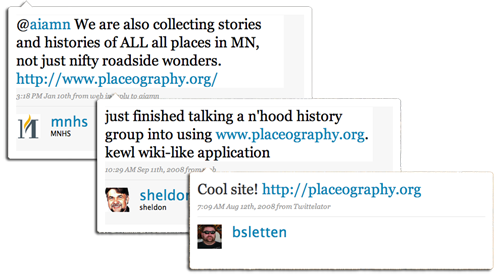
Fig 6: Examples of Twitter Tweets
Print collateral
We invested in a professional printed piece to leave behind at conferences and meetings, and have it available at our museums and Library. It is important to be clear about what action you want the reader to take. Our rack card asks the reader to explore and contribute.
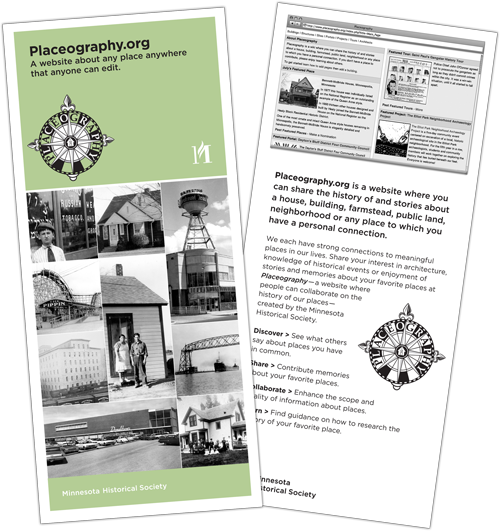
Fig 7: Placeography Brochure
Advertise
On-line advertising provides the best value for targeting specific audiences. The MHS is exploring the use of Facebook ads. A $50 investment yielded 276,000 impressions, 120 clicks, at least 5 probable contributions and one contact from a historical society.
Conclusion
This has been our journey so far. Where we go from here is to continue to foster and grow the Placeography community. We're exploring ways to meet with and reward active partners, such as waiving fees for house history classes for people who submit several entries. We’re working on ways to achieve our goal of having more entries for places outside the Twin Cities metro area, more tours and projects, and more partners documenting Twin Cities neighborhoods and communities not yet on Placeography. Though most of our efforts will concentrate on Minnesota, we’ll continue to engage partnerships outside of our state.
While it may be difficult to attend board meetings of community organizations in Greater Minnesota, we’ll promote Placeography by attending conferences and using social media networks. We will recruit local libraries and local historical societies to foster Placeography in their communities. We'll continue to promote Placeography within our own organization, looking for partnership opportunities as MHS develops exhibits, tours, and projects involving students.
Anyone can start a wiki. To grow a wiki community requires passion for the topic, learning from experience and from our partners, having resources to sustain the site, actively inviting participation, and nurturing committed contributors with a personal touch.
References
King, D.L. (2007). Inviting Participation in Web 2.0. Last updated Wednesday, January 3, 2007. Consulted January 30, 2009. http://www.davidleeking.com/2007/01/03/inviting-participation-in-web-20
Parry, L. (2006). A Tale of Two Wikis: Techniques for building, managing and promoting collaborative communities. Wikimania 2006: Proceedings. Cambridge, MA: The Second International Wikimedia Conference, 2006. Last updated Sunday, September 3, 2006 at 22:18. Consulted January 30, 2009. http://wikimania2006.wikimedia.org/wiki/Proceedings:LP1
Wikipedia contributors (2009). Wikipedia: Notability. Last updated 24 January 2009, at 19:34. Consulted January 30, 2009. http://en.wikipedia.org/wiki/Wikipedia:Notability
Wikipedia contributors (2009). Wikipedia: Verifiability. Last updated Wednesday, January 29, 2009 at 23:15. Consulted January 30, 2009. http://en.wikipedia.org/wiki/Wikipedia:Verifiability

